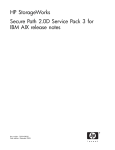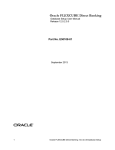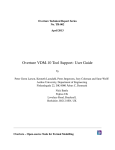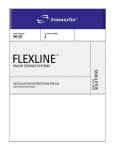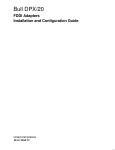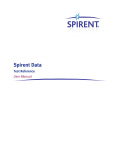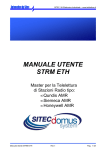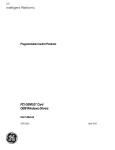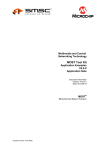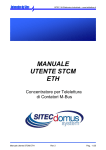Download Cambex AIX User guide
Transcript
FibreQuik Fibre Channel Host Bus Adapter For AIX User Guide Cambex Corporation 115 Flanders Road. Westborough, MA 01581 Customer support [email protected] Document: Date: Rev.: 081-468-042 01/06/04 C FibreQuik - Fibre Channel Adapter User Guide Table of Contents Table of Contents......................................................................................... 1 Description................................................................................................... 2 Specifications............................................................................................... 2 AIX Driver Installation ................................................................................ 3 Command line driver installation............................................................. 3 SMIT Driver Installation.......................................................................... 4 Hardware Installation............................................................................... 4 AIX Configuration ................................................................................... 5 Persistent Bindings................................................................................... 6 SMIT commands...................................................................................... 6 AIX Troubleshooting ............................................................................... 7 Appendix A................................................................................................ 12 Map of SCSI ID to arbitrated loop physical address (ALPA). .............. 12 PC2000 LED Meanings ......................................................................... 13 Declaration of conformity.......................................................................... 14 FCC Warning............................................................................................. 14 Safety Notices ............................................................................................ 14 -1- FibreQuik - Fibre Channel Adapter User Guide Description The Cambex FibreQuik™ Fibre Channel host bus adapters provide attachment of Fibre Channel devices to PCI or Micro Channel based servers. They support the SCSI-FCP protocol. When used with the Cambex Alternate Channel Failover software, two adapters in a system provide greater throughput and total protection from failure of a fibre channel loop. Specifications Model PC2000 PC1000 MC1000 Data rate (each dir.) 200 100 100 MB/s Cable length - copper 30 30 30 m - multimode optical 500 500 500 m - single mode optical 10 10 10 Km Voltage 3.3 or 5 3.3 or 5 5 V Power 7.2 6.5 12.5 W Max adapters / host 16 16 16 Max devices / adapter (AL)126 126 126 (Fabric) 254 254 254 Shipping weight 10 10 15 oz Trademarks Centurion and FibreQuik are trademarks of Cambex Corporation. -2- FibreQuik - Fibre Channel Adapter User Guide AIX Driver Installation Command line driver installation The name and revision level of a driver may be examined by issuing the command (as root): installp -ld <device> where <device> is replaced by /dev/fd0 for the floppy drive, /mnt/AIX/PC1000.image for a CD-ROM mounted at /mnt or the name of a driver image file on the hard disk, typically MC1000.image for Micro Channel systems or PC1000.image for PCI systems. Example output would be: Option Name Level I/U Q Content ================================================== PC1000.driver.obj 01.05.22.00 I N usr Cambex Fibre Channel Adapter Driver Before installing a new version of the driver, delete the previous version of the driver. Note that any filesystems, volume groups and SCSI devices must be removed before removing the driver. Be sure to have a complete backup of all data before attempting to update the driver. The command to remove the driver is: installp -u <name>.driver.obj where name is one of MC1000, PC1000, q2100, q2100m, q2200 or q2200m depending on the type of card and previous driver version. The new driver may be installed on the system with the command: installp -acd <device> all -3- FibreQuik - Fibre Channel Adapter User Guide where <device> is as described above. example: installp -acd /dev/cd0 all After installing the driver, see the README file for additional information more /usr/lpp/cbxfc/READ_ME SMIT Driver Installation The smit path is Software Installation and Maintenance Install and Update Software Install and Update Software by Package Name For the menu item " INPUT device / directory" use /dev/cd0, or the directory where the image file is located. A list should pop up with the name of the driver. Select it and press enter. Hardware Installation Power down the system and install the adapter in a free slot. The PCI card will work in either 32 or 64-bit PCI card slots. Make sure that airflow is not blocked by cables. Observe proper static precautions. Detailed procedures for opening the case may be found in the Operator Guide for the specific RS/6000 model. When using copper cable, it is extremely important that the building wiring present a low impedance ground path to the frame of the device and the host with which it will communicate. Additional ground wiring may be added between the unit and the host to ensure that no electrical noise is impressed on the interconnecting data cables. Noise due to copiers or large machinery sharing the electrical circuits is a common cause of signal integrity problems. -4- FibreQuik - Fibre Channel Adapter User Guide AIX Configuration During power-up initialization, AIX will find and configure the new adapter(s) and any supported devices using the driver's configuration method. Devices are assigned a SCSI ID as they are discovered starting with 0. SCSI ID is not related to loop ID or to SCSI ID assignment on other hosts. Configuration may also be run from the command line: cfgmgr Once disks have been configured, the standard smit utilities may be used to build volume groups, logical volumes and file systems. See the AIX System Management Guide for a detailed explanation. Find out the names of the installed adapters with the command: lsdev -Cc adapter In a loop, the ID of each device must be unique. For disk drives, the ID is typically set by switches on the drive enclosure. The adapter ID is soft assigned and may be examined after it is participating with the mbtest command. If the adapter name found by the lsdev command is scsi1, the command would be: /usr/lpp/cbxfc/mbtest scsi1 id The requested ID may be changed in the database to any nonconflicting value in the range 0 to 126 with the command: chdev -l scsi1 -a id=6 -P -5- FibreQuik - Fibre Channel Adapter User Guide Persistent Bindings Persistent Bindings is the term used to indicate the mapping of SCSI ID to FC Worldwide Name (WWN). By keeping a persistent binding, the loop ID or port ID of a device may change and the device will still be properly addressed. In the Cambex AIX driver, persistent binding is automatic. At configuration time, all devices that are found are automatically assigned to a SCSI ID and a persistent binding is created. Persistent bindings are by port name and are kept in the ODM database. They are preserved and restored at reboot for all FC devices. To display the SCSI ID to WWN mapping for all adapters and devices, issue the command: /usr/lpp/cbxfc/fctest SMIT commands The commands available in SMIT are in the devices menu under Cambex Fibre Channel Adapter: List all Cambex FC adapters This provides the name and location of each adapter. Change / Show Characteristics of an Adapter Allows the user to display and modify attributes. Changeable attributes (with default values in parentheses) are described below. The defaults are chosen to give best performance in most applications.. Attributes used only in loop mode Adapter fibre channel loop ID (0) -6- FibreQuik - Fibre Channel Adapter User Guide Login after LIP (yes) Full duplex in loop mode (no) Attributes used to limit data rate or resources used Execution throttle (256 simultaneous I/O) IOCB allocation (256) DMA window size (PCI only, 64MB) Max frame size (1024) or 512, 2048. Fibre channel rate in GHz for PC2000 (auto) SCSI device types to exclude (none) Topology list (P2P_LOOP) Error recovery Delay after bus reset or other error (10 seconds) Maximum command timeout (300) in seconds Disconnect time before logging an error (60 sec) Generate Error Report Accesses the AIX error logging facility. Trace Cambex FC Adapters Runs the AIX trace facility, looking only for the entries specific to the adapter driver. The trace facility must be installed from fileset bos.sysmgt.trace Change / Show Device Status Shows status of alternate paths to the device and allows manual unfail of paths. (Available with Dynamic Path Failover driver only). Configure Path / Show Path Status Shows path status and allows unconfigured paths to be added. (Available with Dynamic Path Failover driver only). AIX Troubleshooting Use the errpt command to identify the cause of failure. The lsdev command will provide the location of the component. For -7- FibreQuik - Fibre Channel Adapter User Guide example, if errpt identifies a loose cable on device cda1, lsdev will give an address similar to: cda1 Available 00-02-01-3,0 Cambex SCSI... Which indicates that the adapter is in location 00-02, and the drive is at SCSI ID 3, LUN 0. Checklist for driver and HBA installation The following commands may be used to isolate problems during installation of the fibre channel driver and card. Type the command shown in bold and verify the output. whoami must be root uname -a must give 5 fields: 'AIX' hostname where card is installed 1 or higher as minor rev of AIX 4 as version of AIX serial number of host must give: Path: /usr/lib/objrepos PC1000.driver.obj 01.05.00.00 (or greater) Committed Cambex Fibre Channel Adapter Driver lslpp -l PC1000.driver.obj Fileset Level State Description lsdev -Cc adapter should print a line for each card: scsi<x> <x> is a unique number for each SCSI card Available <SS-SS> <S> is the location in the machine where the card is installed Check that the number of SCSI cards and their slots are correct If 'Available' then card and driver are installed. If 'Defined' or not listed then card was not found. -8- FibreQuik - Fibre Channel Adapter User Guide lscfg -vl scsi4 DEVICE scsi4 should print more information for a card: LOCATION 20-58 DESCRIPTION Cambex ... Manufacturer................CAMBEX Machine Type and Model......PC1000F ROS Level and ID............V2.01.19 Serial Number............... 579 Displayable Message.........Cambex ... Network Address.............500502E010000243 Device Specific.(Z0)........Build:TMFtL Device Specific.(Z1)........1.5.13.0 Device Specific.(YL)........P1-I1/Z1 should print the attributes for a card. These are also displayed by SMIT in Change / Show Characteristics of an Adapter. lsattr -El scsi4 bus_io_addr Bus address of board I/O registers bus_intr_lvl Bus interrupt level intr_priority Interrupt priority id Adapter card loop ID exec_throttle Max commands per port max_iocb Max bufers per port retry_delay Delay amount after bus reset (sec) login_on_lip Login all devices after LIP full_duplex Use open full duplex (OPNyx) topology_list Prioritized topology list frame_size Max payload frame length infinity Command timeout infinity (sec) dma_window DMA window size for 64 bit PCI GHz Fibre channel rate in GHz sw_fc_class Class of service devtype_exclude SCSI device type exclude list logout_delay Delay amount after device logout BDR_mask Mask bus device resets • ID may be used to set a hard card loop ID if required. • Exec_throttle may be used to limit simultaneous I/Os to avoid "device busy" errors. • Max_iocb is not used. -9- FibreQuik - Fibre Channel Adapter User Guide • Full_duplex enables higher performance in loop mode where all connected devices support it. P2P is inherently full duplex. • Fibre Channel topology is normally found automatically but may be forced to loop_only or P2P_only with this attribute. • Frame_size defaults to 1K • Infinity is the length of time that the driver will wait for a command before assuming that it has failed. • DMA_window is used to map memory for DMA transfers on PCI bus, 64-bit systems. • GHz is only 1GHz for PC1000 and MC1000 cards. The PC2000 will normally auto-detect but may be forced to 1GHz operation with this attribute. • Sw_fc_class is normally class 3 operation. Contact customer support if class 2 operation is required. • Devtype_exclude will prevent the driver from configuring specific SCSI device types (0 = disk, 1 = tape, etc.) It is used when multiple adapters on the same fabric must not interfere. • Logout_delay is used to specify an upper limit on port logged out responses before failing a command. • BDR_mask is “all” or “none” to mask BDR ioctls. BDR should be masked to tape driver behind a router. cfgmgr -v >/tmp/cfg.log Should identify the card and configure it. If cfg.log contains the ID 77100021 and no driver is found, then the driver is not installed. If an MCA card is present but not configured, then check for and remove the reset jumper on the card. /usr/lpp/cbxfc/mbtest scsi<x> id for each <x> adapter, should return a loop id or port name: - 10 - FibreQuik - Fibre Channel Adapter User Guide Topology: NL AL_PA: 0xef Adapter_ID: 0 or for fabric: Topology: F Port_name: 0x00011000 Adapter_ID: 255 Make sure that the id value doesn't conflict with any other host or device on the same fibre channel loop. The other attributes will be different on each card. During boot, the number displayed when configuring the adapter is hex 0x911 (FC adapter). /usr/lpp/cbxfc/mbtest scsi1 This test code may be used to get fibre channel status from the adapter or from attached devices. /usr/lpp/cbxfc/sctest scsi1 This test code may be used to get IOCINFO information from the adapter or to see the results of SCSI Inquiry or TestUnitReady commands to SCSI devices attached to the adapter. /usr/lpp/cbxfc/fctest This script will print a cross reference between AIX SCSI ID and LUN number and the Fibre Channel WWN and FC LUN as well as PORTID and an internal ID (l_id) used by the driver. /usr/lpp/cbxfc/runtrace This should be run to start a trace if Cambex support requests a trace of the card failure. The AIX trace facility, bos.sysmgt.trace, must be installed. To stop the trace and generate a trace report, type: trcstop; trcrpt > /tmp/trc.log - 11 - FibreQuik - Fibre Channel Adapter User Guide Appendix A Map of SCSI ID to arbitrated loop physical address (ALPA). ID ALPA ID ALPA 0 1 2 3 4 5 6 7 8 9 10 11 12 13 14 15 16 17 18 19 20 21 22 23 24 25 26 27 28 29 30 31 32 33 34 35 36 37 38 39 40 41 42 43 44 45 46 47 48 49 50 51 52 53 54 55 56 57 58 59 60 61 62 63 EF E8 E4 E2 E1 E0 DC DA D9 D6 D5 D4 D3 D2 D1 CE CD CC CB CA C9 C7 C6 C5 C3 BC BA B9 B6 B5 B4 B3 ID ALPA B2 B1 AE AD AC AB AA A9 A7 A6 A5 A3 9F 9E 9D 9B 98 97 90 8F 88 84 82 81 80 7C 7A 79 76 75 74 73 - 12 - 64 65 66 67 68 69 70 71 72 73 74 75 76 77 78 79 80 81 82 83 84 85 86 87 88 89 90 91 92 93 94 95 72 71 6E 6D 6C 6B 6A 69 67 66 65 63 5C 5A 59 56 55 54 53 52 51 4E 4D 4C 4B 4A 49 47 46 45 43 3C ID ALPA 96 97 98 99 100 101 102 103 104 105 106 107 108 109 110 111 112 113 114 115 116 117 118 119 120 121 122 123 124 125 126 3A 39 36 35 34 33 32 31 2E 2D 2C 2B 2A 29 27 26 25 23 1F 1E 1D 1B 18 17 10 0F 08 04 02 01 00 FibreQuik - Fibre Channel Adapter User Guide PC2000 LED Meanings Top LED – Transceiver hardware is detecting a signal. Middle LED – Firmware is being synchronized. Bottom LED – Flashing amber when not synchronized. LED TOP MIDDLE BOTTOM NORM GREEN GREEN OFF - 13 - BAD CABLE GREEN OFF FLASHING NO CONN OFF OFF FLASHING FibreQuik - Fibre Channel Adapter User Guide Declaration of conformity We Cambex Corporation of Waltham, Massachusetts, USA, declare under our sole responsibility, that the products PC-1000, PC-1000F, MC-1000 and MC-1000F are in conformity with the following standards: EN 55022:1994/A1:1995/A2:1997 Class A ITE emissions requirements EN 50082-1:1992 EMC residential, commercial and light industrial generic immunity standard Warning This is a Class A product. In a domestic environment this product may cause radio interference in which case the user may be required to take adequate measures. FCC Warning This equipment has been tested and found to comply with the limits for a class A computing device pursuant to Part 15 of FCC rules which are designed to provide reasonable protection against interference when operating in a commercial environment. This equipment generates, uses and can radiate radio frequency energy and if not installed and used in accordance with the instruction manual may cause interference to radio communications. Operation of this equipment in a residential area is likely to cause interference in which case the users will be required to take whatever measures may be required to correct the interference at their own expense. Changes or modifications of this device could affect the user's authority to operate this equipment. Trademarks FibreQuik is a trademark of Cambex Corporation. - 14 - FibreQuik - Fibre Channel Adapter User Guide Safety Notices Safety Notice Class 1 Laser Product Versions of this product supplied with an optical transceiver meet the safety requirements of a class 1 laser as specified by the US Food and Drug Administration Center of Drug and Radiological Health (CDRH) 21 CFR 1040.10 & 1040.11 and by IEC 825-1. The U.S. Department of Health and Human Services (DHHS) does not consider Class 1 lasers to be hazardous. Customer supplied laser GBICs must meet the same requirements. If in doubt, contact Cambex customer support before operating the product. The International Electrotechnical Commission (IEC) 825 Laser Safety Standard requires labeling in English, German, Finnish, and French stating that the product uses Class 1 lasers. Because it is impractical to label the transceiver, the following label is provided in this manual. CLASS 1 LASER PRODUCT LASER KLASSE 1 LUOKAN 1 LASERLAITE APPAREIL A LASER DE CLASSE 1 TO IEC 825 (1984) + CENELEC HD 482 S1 - 15 -


















